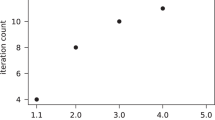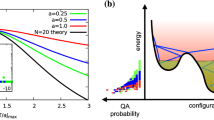Abstract
The discovery of Higgs-boson decays in a background of standard-model processes was assisted by machine learning methods1,2. The classifiers used to separate signals such as these from background are trained using highly unerring but not completely perfect simulations of the physical processes involved, often resulting in incorrect labelling of background processes or signals (label noise) and systematic errors. Here we use quantum3,4,5,6 and classical7,8 annealing (probabilistic techniques for approximating the global maximum or minimum of a given function) to solve a Higgs-signal-versus-background machine learning optimization problem, mapped to a problem of finding the ground state of a corresponding Ising spin model. We build a set of weak classifiers based on the kinematic observables of the Higgs decay photons, which we then use to construct a strong classifier. This strong classifier is highly resilient against overtraining and against errors in the correlations of the physical observables in the training data. We show that the resulting quantum and classical annealing-based classifier systems perform comparably to the state-of-the-art machine learning methods that are currently used in particle physics9,10. However, in contrast to these methods, the annealing-based classifiers are simple functions of directly interpretable experimental parameters with clear physical meaning. The annealer-trained classifiers use the excited states in the vicinity of the ground state and demonstrate some advantage over traditional machine learning methods for small training datasets. Given the relative simplicity of the algorithm and its robustness to error, this technique may find application in other areas of experimental particle physics, such as real-time decision making in event-selection problems and classification in neutrino physics.
This is a preview of subscription content, access via your institution
Access options
Access Nature and 54 other Nature Portfolio journals
Get Nature+, our best-value online-access subscription
$29.99 / 30 days
cancel any time
Subscribe to this journal
Receive 51 print issues and online access
$199.00 per year
only $3.90 per issue
Buy this article
- Purchase on Springer Link
- Instant access to full article PDF
Prices may be subject to local taxes which are calculated during checkout





Similar content being viewed by others
References
Chatrchyan, S. et al. Observation of a new boson at a mass of 125 GeV with the CMS experiment at the LHC. Phys. Lett. B 716, 30–61 (2012)
Aad, G. et al. Observation of a new particle in the search for the standard model Higgs boson with the ATLAS detector at the LHC. Phys. Lett. B 716, 1–29 (2012)
Kadowaki, T. & Nishimori, H. Quantum annealing in the transverse Ising model. Phys. Rev. E 58, 5355–5363 (1998)
Das, A. & Chakrabarti, B. K. Colloquium: Quantum annealing and analog quantum computation. Rev. Mod. Phys. 80, 1061–1081 (2008)
Neven, H., Denchev, V. S., Rose, G. & Macready, W. G. Training a binary classifier with the quantum adiabatic algorithm. Preprint at http://arXiv.org/abs/0811.0416 (2008)
Pudenz, K. L. & Lidar, D. A. Quantum adiabatic machine learning. Quantum Inf. Process. 12, 2027–2070 (2013)
Kirkpatrick, S., Gelatt, C. D. & Vecchi, M. P. Optimization by simulated annealing. Science 220, 671–680 (1983)
Katzgraber, H. G., Trebst, S., Huse, D. A. & Troyer, M. Feedback-optimized parallel tempering monte carlo. J. Stat. Mech. 2006, P03018 (2006)
Chollet, F. Keras, https://github.com/fchollet/keras (2015)
Chen, T. & Guestrin, C. XGBoost: a scalable tree boosting system. Preprint at https://arxiv.org/abs/1603.02754 (2016)
Khachatryan, V. et al. Observation of the diphoton decay of the Higgs boson and measurement of its properties. Eur. Phys. J. C 74, 3076 (2014)
Aad, G. et al. Measurement of Higgs boson production in the diphoton decay channel in pp collisions at center-of-mass energies of 7 and 8 TeV with the ATLAS detector. Phys. Rev. D 90, 112015 (2014)
Patrignani, C. et al. Review of particle physics. Chin. Phys. C 40, 100001 (2016)
Englert, C., Plehn, T., Zerwas, D. & Zerwas, P. M. Exploring the Higgs portal. Phys. Lett. B 703, 298–305 (2011)
Morrissey, D. E. & Ramsey-Musolf, M. J. Electroweak baryogenesis. New J. Phys. 14, 125003 (2012)
Buttazzo, D. et al. Investigating the near-criticality of the Higgs boson. J. High Energy Phys. 12, 89 (2013)
Adam-Bourdarios, C. et al. The Higgs machine learning challenge. J. Phys. Conf. Ser. 664, 072015 (2015)
Albash, T., Vinci, W., Mishra, A., Warburton, P. A. & Lidar, D. A. Consistency tests of classical and quantum models for a quantum annealer. Phys. Rev. A 91, 042314 (2015)
Al-Rfou, R. et al. Theano: a Python framework for fast computation of mathematical expressions. Preprint at http://arxiv.org/abs/1605.02688 (2016)
Chen, J. et al. Interpreting the prediction process of a deep network constructed from supervised topic models. In IEEE Int. Conf. Acoustics, Speech and Signal Processing 2429–2433 (IEEE, 2016)
Lloyd, S., Mohseni, M. & Rebentrost, P. Quantum principal component analysis. Nat. Phys. 10, 631–633 (2014)
Wiebe, N., Kapoor, A. & Svore, K. Quantum algorithms for nearest-neighbor methods for supervised and unsupervised learning. Quantum Inf. Comput. 15, 318–358 (2015)
Paparo, G. D., Dunjko, V., Makmal, A., Martin-Delgado, M. A. & Briegel, H. J. Quantum speedup for active learning agents. Phys. Rev. X 4, 031002 (2014)
Rebentrost, P., Mohseni, M. & Lloyd, S. Quantum support vector machine for big data classification. Phys. Rev. Lett. 113, 130503 (2014)
Schuld, M., Sinayskiy, I. & Petruccione, F. An introduction to quantum machine learning. Contemp. Phys. 56, 172–185 (2015)
Cong, I. & Duan, L. Quantum discriminant analysis for dimensionality reduction and classification. New J. Phys. 18, 073011 (2016)
Biamonte, J. et al. Quantum machine learning. Nature 549, 195–202 (2017)
Sjöstrand, T., Mrenna, S. & Skands, P. PYTHIA 6.4 physics and manual. J. High Energy Phys. 5, 26 (2006)
Gleisberg, T. et al. Event generation with SHERPA 1.1. J. High Energy Phys. 2, 7 (2009)
Acknowledgements
This project is supported in part by the United States Department of Energy, Office of High Energy Physics Research Technology Computational HEP and Fermi Research Alliance, LLC under contract no. DE-AC02-07CH11359. The project is also supported in part under ARO grant number W911NF-12-1-0523 and NSF grant number INSPIRE-1551064. The work is supported in part by the AT&T Foundry Innovation Centers through INQNET, a programme for accelerating quantum technologies. We thank the Advanced Scientific Computing Research programme of the DOE for the opportunity to present and discuss this work at the ASCR workshop on Quantum Computing for Science (2015). We acknowledge the funding agencies and all of the scientists and staff at CERN and internationally whose hard work resulted in the momentous H(125) discovery in 2012.
Author information
Authors and Affiliations
Contributions
A.M. mapped the problem on the D-Wave software architecture, analysed the data, provided the machine learning methodology and, with M.S., provided knowledge of Higgs physics. J.J. provided quantum and simulated annealing research, data analysis, machine learning work and, with D.L., quantum and simulated annealing knowledge. J.-R.V. provided quantum annealing research, data analysis, machine learning methods and error analysis, with J.J. D.L. and M.S. oversaw the work, data analysis and results. D.L. conceived the quantum machine learning methodology. M.S. conceived the application. All authors contributed to writing and reviewing the manuscript.
Corresponding author
Ethics declarations
Competing interests
The authors declare no competing financial interests.
Additional information
Reviewer Information Nature thanks S. Zohren and the other anonymous reviewer(s) for their contribution to the peer review of this work.
Publisher's note: Springer Nature remains neutral with regard to jurisdictional claims in published maps and institutional affiliations.
Supplementary information
Supplementary Information
This file contains Supplementary Text and Data, Supplementary Figures 1-18 and Supplementary References. (PDF 1961 kb)
Supplementary Data
This zipped file contains data relating to the figures. (ZIP 34239 kb)
Rights and permissions
About this article
Cite this article
Mott, A., Job, J., Vlimant, JR. et al. Solving a Higgs optimization problem with quantum annealing for machine learning. Nature 550, 375–379 (2017). https://doi.org/10.1038/nature24047
Received:
Accepted:
Published:
Issue Date:
DOI: https://doi.org/10.1038/nature24047
This article is cited by
-
How to experimentally evaluate the adiabatic condition for quantum annealing
Scientific Reports (2024)
-
Review of Applications of Quantum Computing in Power Flow Calculation
Journal of Electrical Engineering & Technology (2024)
-
Hybrid quantum-classical machine learning for generative chemistry and drug design
Scientific Reports (2023)
-
Nonnegative/Binary matrix factorization for image classification using quantum annealing
Scientific Reports (2023)
-
An Explainable MRI-Radiomic Quantum Neural Network to Differentiate Between Large Brain Metastases and High-Grade Glioma Using Quantum Annealing for Feature Selection
Journal of Digital Imaging (2023)
Comments
By submitting a comment you agree to abide by our Terms and Community Guidelines. If you find something abusive or that does not comply with our terms or guidelines please flag it as inappropriate.



